Map exposes America's tripledemic of Covid, flu and RSV infections… so, how bad is it in YOUR state?
A map showing the number of respiratory infections in the US reveals a 'sea of red' – as the US is hit again by a tripledemic of viruses this winter.
Thirty-eight states are now reporting 'high' or 'very high' levels of flu-like illness, official data shows, while Covid hospitalizations have risen by almost 30 per cent in a week.
Cases of respiratory syncytial virus (RSV) – a common cold disease that kills thousands of babies and seniors every year – are still unusually high.
And the rise in cases has prompted hospitals in at least 14 states to bring back mandatory face masks for patients, visitors and staff.
Your browser does not support iframes.
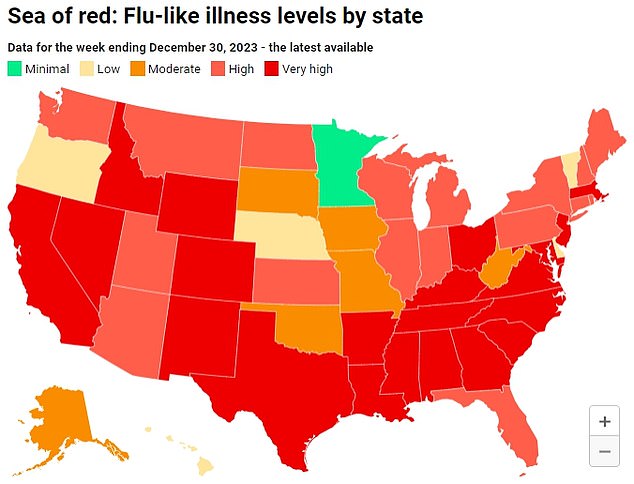
The map above shows the number of flu-like illnesses by state in the week to December 30, the latest available
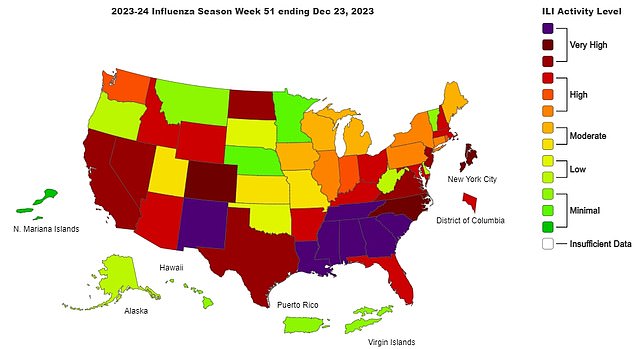

The map above shows flu-like illnesses by state in the week to December 23, just before the last available case
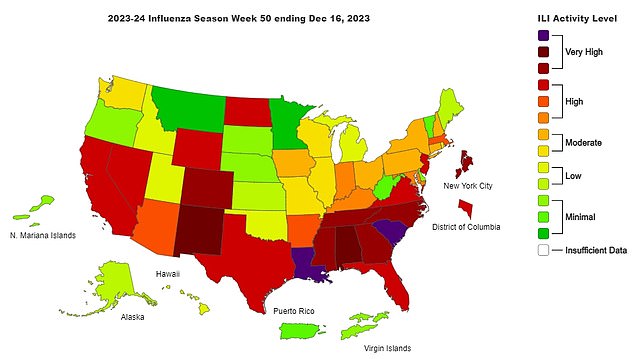

And the above shows flu-like illnesses by state in the week to December 16, two weeks before the last week available
Based on the latest data from the Centers for Disease Control and Prevention, which collects information from 3,400 hospitals across the country, there were 38 states with “high” or “very high” levels in the week ending Dec. 30 reaches.
Flu activity is high or very high in regions across the country, with only some areas in the Plains and Midwest experiencing lower levels.
Only one state – Minnesota – still has a minimum flu level.
Rates of respiratory illness are normally high around this time of year, before infections peak in January and February.
But the earlier season, coupled with children's underdeveloped immune systems due to successive lockdowns, has raised fears that the US could be in for a bigger wave.
The CDC reports that visits to a health care provider for a respiratory illness increased seven percent in the week ending December 30, with 20,000 new hospitalizations.
Data shows that 10 million people have been infected with flu so far this season, while 110,000 people have been hospitalized.
By comparison, at this point in 2019 – before the pandemic – 7 million illnesses and 55,000 hospital admissions had been recorded.
Estimates show that a total of 6,500 deaths from flu have also occurred, compared to 2,900 at the same time in 2019.
During the 2023-2024 cold winter season, there have been 27 deaths among children.
In total, around 20,000 new admissions of people with flu were reported in the week to December 30, data shows.
This was 36 percent higher than the 14,700 reports during the previous seven-day period.
Covid-19 hospital admissions are also rising, up 20 per cent in a week to 34,800 over the past seven days.
And there are also signs that RSV is causing more illness, with an estimated 125,000 cases detected last week – up from 119,000 the week before.
Dr. Jacob Glanville, a virologist based in San Francisco who is working on a universal flu vaccine, told DailyMail.com that this was shaping up to be a “tough winter” for viruses.
“We normally see an increase in respiratory viruses after the holidays,” he said.
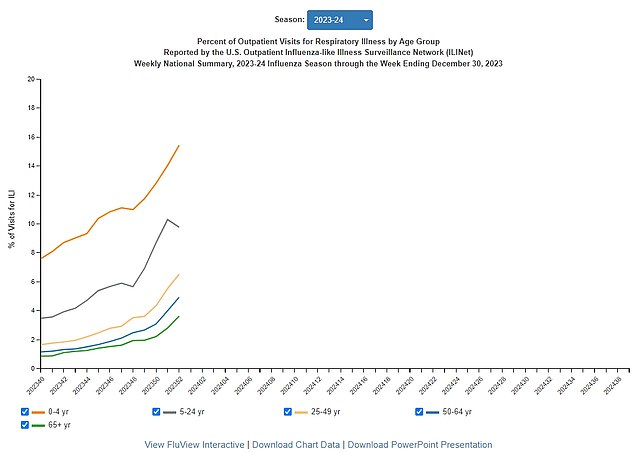

The above shows the proportion of people admitted to hospital with a flu-like illness, by age group. This shows that children form the largest group
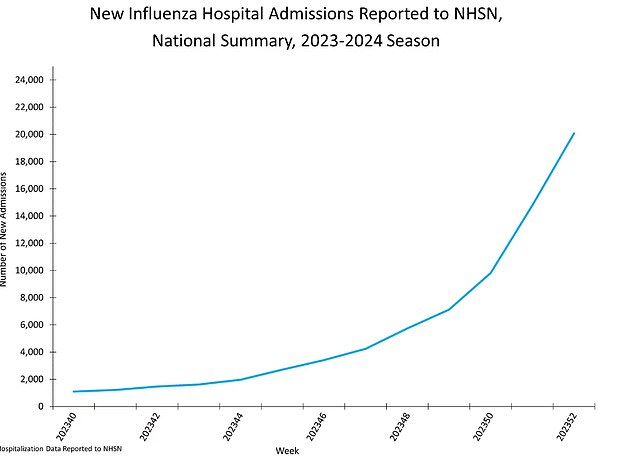

Flu hospitalizations continue to rise, with data suggesting hospital admissions have already doubled in the 2019-2020 season before the Covid pandemic
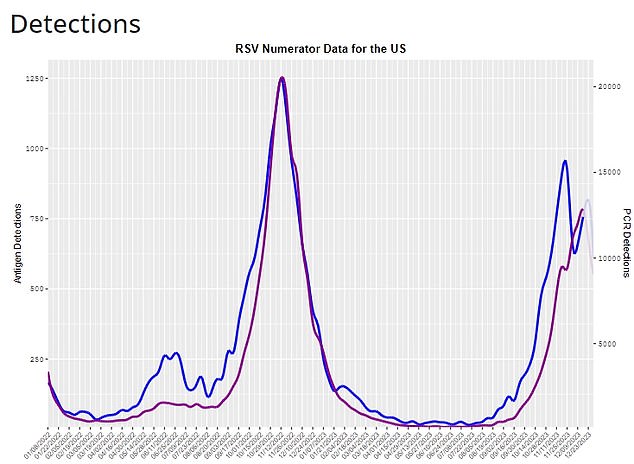

RSV infections are also starting to rise again, after new CDC director Dr. Mandy Cohen suggested they had peaked
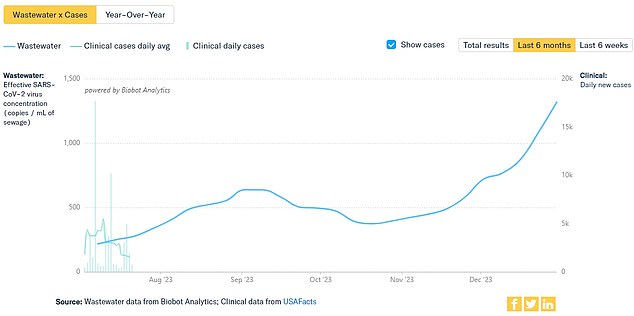

The above shows Covid infections according to wastewater. They keep rising
“To date, CDC data shows that Covid-19-led hospitalizations are not at the same levels as the previous three winters. But a lot of uncertainty remains about how big the current peak could be.
“Everyone should make sure they wash their hands, cover up coughs and stay up to date on their vaccines.”
Amid rising infection levels, hospitals across the US are now beginning to reinstate mask mandates to help stop the spread of infections.
Last week, hospitals in four states — New York, California, Illinois and Massachusetts — became the latest to bring back mandates on staff, patients and visitors.
There is limited evidence that masks help prevent the spread of infections, but hospitals use them because staff are likely to show up to work sick, increasing the risk of virus spread.
On Friday night, the city of St. Louis became the first city this season to bring back a mask mandate for non-healthcare workers — saying its 3,000 employees would now have to wear the covering indoors.
“With winter virus activity increasing at such a rapid pace, we must take action to slow transmission and prevent strain on our hospital system,” the city's Department of Health said.
However, later that day they changed course and said they now 'strongly recommend' face masks.
Republican lawmakers in the state said the turnaround was achieved after Gov. Mike Parson intervened.
A spokesperson for the governor said, “Governor Parson has kept his word. “There has been a conversation with the St. Louis Mayor's Office and as a result, new policies have been issued that reverse the previous mask mandate.”
